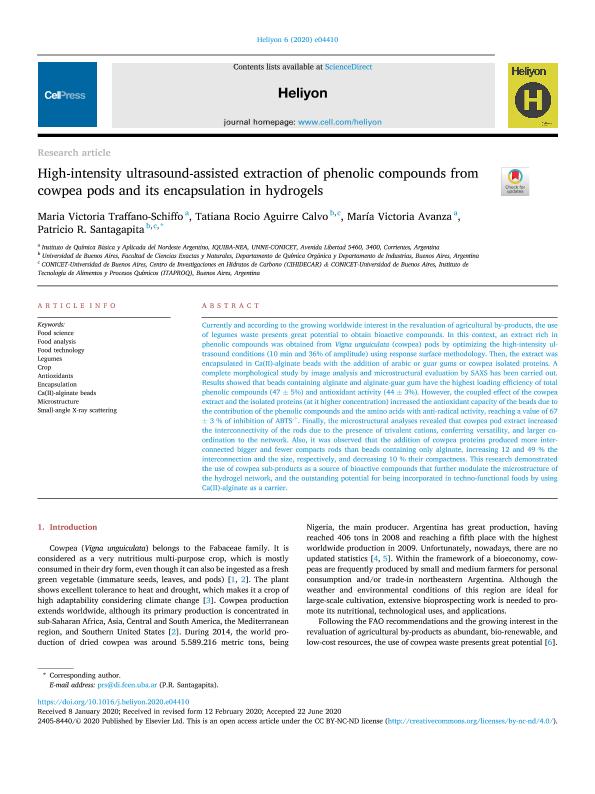Mostrar el registro sencillo del ítem
dc.contributor.author
Traffano Schiffo, Maria Victoria

dc.contributor.author
Aguirre Calvo, Tatiana Rocio

dc.contributor.author
Avanza, María Victoria

dc.contributor.author
Santagapita, Patricio Roman

dc.date.available
2021-04-23T17:25:57Z
dc.date.issued
2020-07
dc.identifier.citation
Traffano Schiffo, Maria Victoria; Aguirre Calvo, Tatiana Rocio; Avanza, María Victoria; Santagapita, Patricio Roman; High-intensity ultrasound-assisted extraction of phenolic compounds from cowpea pods and its encapsulation in hydrogels; Elsevier; Heliyon; 6; 7; 7-2020; 1-11
dc.identifier.issn
2405-8440
dc.identifier.uri
http://hdl.handle.net/11336/130785
dc.description.abstract
Currently and according to the growing worldwide interest in the revaluation of agricultural by-products, the use of legumes waste presents great potential to obtain bioactive compounds. In this context, an extract rich in phenolic compounds was obtained from Vigna unguiculata (cowpea) pods by optimizing the high-intensity ultrasound conditions (10 min and 36% of amplitude) using response surface methodology. Then, the extract was encapsulated in Ca(II)-alginate beads with the addition of arabic or guar gums or cowpea isolated proteins. A complete morphological study by image analysis and microstructural evaluation by SAXS has been carried out. Results showed that beads containing alginate and alginate-guar gum have the highest loading efficiency of total phenolic compounds (47 +/- 5%) and antioxidant activity (44 +/- 3%). However, the coupled effect of the cowpea extract and the isolated proteins (at it higher concentration) increased the antioxidant capacity of the beads due to the contribution of the phenolic compounds and the amino acids with anti-radical activity, reaching a value of 67 +/- 3 % of inhibition of ABTS.+. Finally, the microstructural analyses revealed that cowpea pod extract increased the interconnectivity of the rods due to the presence of trivalent cations, conferring versatility, and larger coordination to the network. Also, it was observed that the addition of cowpea proteins produced more interconnected bigger and fewer compacts rods than beads containing only alginate, increasing 12 and 49 % the interconnection and the size, respectively, and decreasing 10 % their compactness. This research demonstrated the use of cowpea sub-products as a source of bioactive compounds that further modulate the microstructure of the hydrogel network, and the outstanding potential for being incorporated in techno-functional foods by using Ca(II)-alginate as a carrier.
dc.format
application/pdf
dc.language.iso
eng
dc.publisher
Elsevier

dc.rights
info:eu-repo/semantics/openAccess
dc.rights.uri
https://creativecommons.org/licenses/by-nc-sa/2.5/ar/
dc.subject
ANTIOXIDANTS
dc.subject
CA(II)-ALGINATE BEADS
dc.subject
CROP
dc.subject
ENCAPSULATION
dc.subject
FOOD ANALYSIS
dc.subject
FOOD SCIENCE
dc.subject
FOOD TECHNOLOGY
dc.subject
LEGUMES
dc.subject
MICROSTRUCTURE
dc.subject
SMALL-ANGLE X-RAY SCATTERING
dc.subject.classification
Alimentos y Bebidas

dc.subject.classification
Otras Ingenierías y Tecnologías

dc.subject.classification
INGENIERÍAS Y TECNOLOGÍAS

dc.title
High-intensity ultrasound-assisted extraction of phenolic compounds from cowpea pods and its encapsulation in hydrogels
dc.type
info:eu-repo/semantics/article
dc.type
info:ar-repo/semantics/artículo
dc.type
info:eu-repo/semantics/publishedVersion
dc.date.updated
2020-08-05T15:18:54Z
dc.journal.volume
6
dc.journal.number
7
dc.journal.pagination
1-11
dc.journal.pais
Reino Unido

dc.journal.ciudad
Londres
dc.description.fil
Fil: Traffano Schiffo, Maria Victoria. Consejo Nacional de Investigaciones Científicas y Técnicas. Centro Científico Tecnológico Conicet - Nordeste. Instituto de Química Básica y Aplicada del Nordeste Argentino. Universidad Nacional del Nordeste. Facultad de Ciencias Exactas Naturales y Agrimensura. Instituto de Química Básica y Aplicada del Nordeste Argentino; Argentina
dc.description.fil
Fil: Aguirre Calvo, Tatiana Rocio. Universidad de Buenos Aires. Facultad de Ciencias Exactas y Naturales. Departamento de Industrias. Instituto de Tecnología de Alimentos y Procesos Químicos. Consejo Nacional de Investigaciones Científicas y Técnicas. Oficina de Coordinación Administrativa Ciudad Universitaria. Instituto de Tecnología de Alimentos y Procesos Químicos; Argentina
dc.description.fil
Fil: Avanza, María Victoria. Consejo Nacional de Investigaciones Científicas y Técnicas. Centro Científico Tecnológico Conicet - Nordeste. Instituto de Química Básica y Aplicada del Nordeste Argentino. Universidad Nacional del Nordeste. Facultad de Ciencias Exactas Naturales y Agrimensura. Instituto de Química Básica y Aplicada del Nordeste Argentino; Argentina
dc.description.fil
Fil: Santagapita, Patricio Roman. Universidad de Buenos Aires. Facultad de Ciencias Exactas y Naturales. Departamento de Industrias. Instituto de Tecnología de Alimentos y Procesos Químicos. Consejo Nacional de Investigaciones Científicas y Técnicas. Oficina de Coordinación Administrativa Ciudad Universitaria. Instituto de Tecnología de Alimentos y Procesos Químicos; Argentina
dc.journal.title
Heliyon
dc.relation.alternativeid
info:eu-repo/semantics/altIdentifier/url/https://linkinghub.elsevier.com/retrieve/pii/S2405844020312548
dc.relation.alternativeid
info:eu-repo/semantics/altIdentifier/doi/http://dx.doi.org/10.1016/j.heliyon.2020.e04410
Archivos asociados
